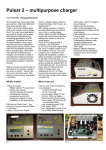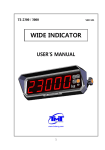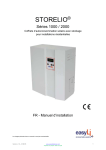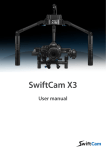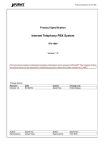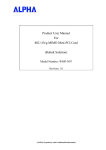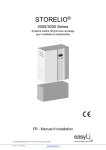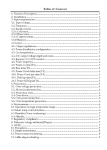Download User`s Manual 8kW Fast Charging Battery
Transcript
www.lowcarbon-idea.com [email protected] Manual 8kW User’s Manual 8kW Fast Charging Battery Charger With CAN interface IGBT power modules inside P.1 www.lowcarbon-idea.com [email protected] Manual 8kW contents Overview......................................................................................................................P3 Performance................................................................................................................P4 Specification.................................................................................................................P5 Front operation panel...................................................................................................P6 Rear operation panel...................................................................................................P7 Inner structure & packing.............................................................................................P8 P.2 www.lowcarbon-idea.com [email protected] Manual 8kW Overview This smart charger for electric vehicle uses high-frequency switching power supply technology, which learn from and absorb the advanced control technology designed. It is a practical, functional and reliable products.This electric vehicle charger is light weight, small size, charge stability, high efficiency, anti-seismic capability, safety and reliability. And it has under voltage, over voltage, reverse polarity, short circuit, overload protection. Curve with a reasonable charge and SCM control the charging process to ensure that the battery is fully charged, and extend the battery life. The principle of introduction: This charger apply full bridge rectification principle. AC input rectifier bridge for the first time into the rectifier filter, resulting in a smooth DC voltage, and the DC voltage through full bridge inverter, generate high frequency AC signal, then the high-frequency alternating current after the second rectifier filter, produces a smooth DC. 65C thermal protection AC input DC output Control PCB First filtering First rectify Second rectify Second filtering P.3 Full bridge convert www.lowcarbon-idea.com [email protected] Manual 8kW The charge curve Charging process description: 1.Preconditioning Charge: when charging machine starts, first 3-5A charging current for four minutes, and then high current charging. Four minutes is a small current to activate the battery charging purposes the chemical reaction inside the battery fully established, to avoid charging the battery in the cold state; 2.After four minutes the end of a small current, the charging unit into the preset current (eg 20A) constant current charging phase. When the voltage charge to a preset voltage (eg 400V), the charger reduces the charge without entering the voltage constant current value of the stage. Since then continue to detect the charging voltage, when the battery voltage again reaches 400V, the charger reduces the charge current once again (each time decreasing 2A), repeatedly until the charging current over the charging process to 2A, the charger that the battery is fully charged and shut down; 3. Charging authorities in the no-load machine just off the charge rather than the whole state down. P.4 www.lowcarbon-idea.com [email protected] Manual 8kW Working conditions: 1. Suitable the battery type: Lead-acid battery, Li-FePO4 battery, NI-MH battery. 2. Altitude: not exceeding 1,200 m. 3. Ambient temperature: -20 °C ~ +50°C . 4. Relative humidity: 30%~90%. 5. To ensure placement in the No explosive material charge location, there is no corrosion of metal and insulation damage to the gas or steam, dry and ventilated environment. 6.No severe vibration and shock, the vertical gradient of not more than 5%. 7.the grid voltage fluctuation range of continuing convergence value does not exceed the rated ± 5%, short-term fluctuations (less than 1 second) does not exceed 10% of the fundamental peak instantaneous volatility of not more than 20%. Features: 1.According to the design characteristics of the battery charge a reasonable curve, both full of batteries and can extend battery life. 2.Easy to use, simple maintenance, intelligent charging, without human duty. 3.the protection function. Over voltage, under voltage, over current, over heating, short circuit, output reverse polarity protection, etc. 4.Intuitive and strong. Charging process and the failure by the LCD screen display, can at a glance. 5.Using high-frequency soft switch technology, making the charger and high efficiency, small size, light weight. 6.Charger fan switch control by the temperature 45 °C, when the radiator temperature is below 45 °C, the fan does not rotate. When the radiator temperature is higher than 45 ? , the fans began to turn, can reduce noise and extend fan life. The major technical specification: 1) The input is AC380V (three-phase three-wire); 2) Input voltage and frequency to adapt to wide range of power in the AC 380V ± 10%, and frequency of 50Hz ± 10% enter the work can be stable and reliable; 3) DC output value from 40-400V continuously adjustable. 4) Output DC Current value from 5-20A potentiometer continuously adjustable; 5) Load regulation: ≤ 1%; 6) voltage regulation rate: ≤ 1% load regulation: ≤ 1%; 7) Ripple Voltage: ≤ 1%; 8) Leakage current: ≤ 10mA; 9) Duty cycle: 100%; 10) the overall efficiency: ≥ 92% (full load); 11) Power factor: ≥ 0.80 (full load); 12) Insulation resistance: DC1000V test ≥ 50MΩ; 13) Charging Mode: Auto + Manual; 14) With charging voltage, current, charge status, display and parameter setting functions; 15) With failure alarm and display; 16) With pre-constant current charging, constant voltage float late, full auto-stop function; 17) Protection class: IP32; 18) Cooling: Air Cooled; 19) With the protection function of fatal error (such as load reverse polarity, input and output short circuit) P.5 www.lowcarbon-idea.com [email protected] Manual 8kW shutdown, the general error alarm function; 20) With over voltage, under voltage, over current, over heating, lack phase, corresponding to short-circuit protection; Front operation panel Front operation panel introduction ON / OFF switch: When to start charging machine, please switch to the ON position, when the charger need to turn off, please the switch to the OFF position. REMOTE / LOCAL: When the switch to the REMOTE position, the charger from the CAN control, manual operation is not Work; when the switch on the LOCAL position: CAN communication cut off, charging into the machine by manual operation way. SET / WORK: When the manual operation, first press the SET switch position, the voltage and current values can be set manually. When the voltage and current value finish setting, put the switch to the WORK position to start charging machine according to previous setting . VOLAGE (V): Display the actual output of charging voltage value. CURRENT (A): Display the actual output current work. VOLTAGE: Voltage adjustment potentiometer to change the voltage value. CURRENT: Current adjustment potentiometer to change the current value. BATTREY: This LED will be light after the battery connections correctly. CHARGE: When charging is normal this LED will be light. ERROR: When the reverse or short circuit P.6 www.lowcarbon-idea.com [email protected] Manual 8kW Rear operation panel introduction 40 0m m 390mm 300mm AC INPUT: AC 3-phase 380V; OUTPUT: DC output, the red terminal is positive, the black terminal is negative; CAN: CAN communication, 1 foot (red line) is high, 2 feet (black line) is low. Wiring connection: 1.Firstly, take the charger and the battery connected, the red terminal is positive output, access to battery positive, black-side output is negative, access to the battery negative. 2.the AC input connected, the input for the three-phase 380V, three-phase for the firing line, there is no zero line. 3.Please take a good ground to avoid danger. 4.Turn on the AC switch, charger start. Operation option 1.Firstly, open the voltage switch, then select the charging mode. 2.When the manual operation, please select LOCAL mode, if controled through the CAN, select REMOTE mode; 3. When you select LOCAL mode, turn the SET / WORK switch to the SET position, according to your need to set the voltage, current, and the turn to WORK position then the charger start to work. 4.When you select REMOTE mode, please connect the CAN communication lines with the BMS or outer company. P.7 www.lowcarbon-idea.com [email protected] Manual 8kW Inner structure main PCB control PCB power switch cooling fin IGBT resistor IGBT drive board Transformer capacitor Packing m 560m 470mm 400mm 1 P.8 Version˖0A 27 28 24 1 DP 23 8 22 7 21 6 20 5 19 4 PDU FORMAT(PF) 18 3 I D E S R R 17 2 1 16 PF 15 8 14 7 13 6 12 5 11 4 10 3 PDU SPECIFIC(PS) 9 2 8 1 IDENTIFIER EXTENSION 7 8 6 7 5 6 4 5 3 4 2 3 1 2 SOURCE ADDRESS(SA) 18BYTES 1 0 1 239(0xEF) 244(0xF4) 229(0xE5) 230(0xE6) 80(0x50) Motor Controller Battery Management System˄BMS˅ Charger Control System˄CCS˅ Charger Control System 2˄CCS2˅ Broadcast Address˄BCA˅ Node Name SOURCE ADDRESS(SA) CAN Network Address Distribution Obtain the node address of CAN Bus from the definition of J1939 Standard˖ ›There is a name and an address for every node which accesses to the network. The name is used for nodes identification and address arbitration. The address is used for data communication to node. ›Every node has at least one function. Multiple nodes might have the same function or one node might have multiple functions. Herein, Priority has 3-bit and there can be 8 priority levels. R is generally fixed as 0. DP is fixed as 0 at present. 8-byte PF is the code for message. 8-byte PS refers to destination address or array extension. 8-byte SA refers to the source address for sending messages. 26 25 1 2 3 1 R PRIORITY IDENTIFIER 11BYTES I D E S R R 1ˊ ˊCommunication Specification The principle for data link layer. Communication speed for bus line: 250Kbps. The provision for data link layer: Refer to the related regulation of CAN2.0B and J1939. Use and redefine 29 identifiers of CAN extended frame. The distribution of 29 identifiers are listed below: BMS: CAN BUS COMMUNICATION SPECIFICATION Document Number˖0010 0 6 Max Allowable Charging Terminal Voltage Low Byte (VOL_SET_L) Max Allowable Charging Current High Byte (VOL_SET_H) Max Allowable Charging Current Low Byte (VOL_SET_L) Control Reserved Reserved Reserved BYTE2 BYTE3 BYTE4 BYTE5 BYTE6 BYTE7 BYTE8 ID CCS BMS Position IN OUT Data Name 0 6 Data R P ID 1000 offset:0 e.g. Iset=582, its corresponding 58.2A offset:0 e.g. Vset=3201, its corresponding 320.1V 6 PF Cycle Time (ms) 2 0 DP 6 PF 1000 Cycle Time(ms) 0: Charger is open and on charge. 1:Battery protection, the charger closes its output. 0.1A/byte 0.1V/byte 0 DP Message 10: (ID: 0x1806E6F4) new added message( only available for charging station) Max Allowable Charging Terminal Voltage High Byte(VOL_SET_H) BYTE1 Data R P Data Name CCS BMS Version˖0A Position IN OUT Message Format Message1: (ID: 0x1806E5F4) Document Number˖0010 Max Allowable Charging Terminal Voltage Low Byte (VOL_SET_L) Max Allowable Charging Current High Byte (CUR_SET_H) Max Allowable Charging Current Low Byte (CUR_SET_L) Control (CONTROL_FLG) Max Allowable Discharging Current (DISCUR_MAX) Reserved page=1 BYTE2 BYTE3 BYTE4 BYTE5 BYTE6 BYTE7 BYTE8 Battery Actual AH High Byte Battery Actual AH Low Byte BYTE3 BYTE4 Single Battery Max Protection Voltage High Byte (VOL_CELL_OV_protect_H) Single Battery Max Protection Voltage Low Byte (VOL_CELL_OV_protect_L) Battery Numbers (BATTER_NUM) page=2 BYTE5 BYTE6 BYTE7 BYTE8 (AH_actual_L) (AH_actual_H) Battery Nominal AH Low Byte (AH_marker_L) (AH_marker_H) BYTE2 Battery Nominal AH High Byte BYTE1 0 6 Data R P Data Name CCS BMS Position IN OUT ID offset:0 e.g. Iset=582, its corresponding 58.2A offset:0 e.g. Vset=3201, its corresponding 320.1V 3 =1 10A/byte 0 =2 1-255 6 PF 1000 0: Invalid Information, refer to page 5. 1mV /byte 0.1AH/byte 0.1AH/byte DP Cycle Time(ms) offset:0 e.g. Iset=2, its corresponding 20A 0: Charger is open and on charge. 1:Battery protection, the charger closes its output. 0.1A/byte 0.1V/byte Message 11: (ID: 0x1806E6F4) new added message( only available for charging station) Max Allowable Charging Terminal Voltage High Byte (VOL_SET_H) Version˖0A BYTE1 Document Number˖0010 Version˖0A Single Battery Min Protection Voltage High Byte Single Battery Min Protection Voltage Low Byte BYTE5 BYTE6 0 DP (VOL_CELL_ULV_protect_L) (VOL_CELL_ULV_protect_H) (VOL_CELL_MIN_L) 0 6 Battery Pack Total Voltage High Byte (VOL_BATTER_H) Battery Pack Total Voltage Low Byte (VOL_BATTER_L) Actual Charging Current High Byte (CUR_CHARGE_H) Actual Charging Current Low Byte (CUR_CHARGE_L) BYTE1 BYTE2 BYTE3 BYTE4 Data R P Data Name CCS BMS Position IN OUT ID 6 PF 1000 Cycle Time(ms) 4 =3 Max byte means mark. 6 PF 0: charging; 1000 1: Cycle Time(ms) Byte0˖over-voltage mark, Byte1:under-voltage mark. Normal:0x00 1mV /byte 1mV /byte 1mV /byte 0.1A/byte offset:0 discharging 0.1V/byte 0 DP Message 13: (ID: 0x1806E6F4) new added message( only available for charging station) page=3 Single Battery Min Voltage Low Byte BYTE4 (VOL_CELL_MIN_H) BYTE8 Single Battery Min Voltage High Byte BYTE3 (VOL_CELL_MAX_L) Battery State ˄BATTER_STATE˅ Single Battery Max Voltage Low Byte BYTE2 ID (VOL_CELL_MAX_H) BYTE7 Single Battery Max Voltage High Byte BYTE1 0 6 Data R P Data Name CCS BMS Position IN OUT Message 12: (ID: 0x1806E6F4) new added message( only available for charging station) Document Number˖0010 0 6 Output Voltage High Byte Output Voltage Low Byte BYTE1 BYTE2 0 6 Data R P Data Name BCA CCS Position IN OUT Message 2: (ID: 0x18FF50E5) BYTE8 BYTE7 BYTE6 BYTE5 BYTE4 page=5 Battery Numbers Low Byte (BATTER_NUM _L) BYTE2 BYTE3 Battery Numbers High Byte (BATTER_NUM_H) BYTE1 Data R P Data Name CCS BMS Position IN OUT ID ID 0 DP 0.1V/byte =5 0xFF PF 6 1000 Cycle Time(ms) 1000 offset:0 e.g. Vout=3201, its corresponding 320.1V 0: Invalid Information 0 DP Message 14: (ID: 0x1806E6F4) new added message( only available for charging station) PF 义 page=4 BYTE8 Cycle Time(ms) 1 degree/byte, offset 100. eg: 0:-100 degree, 125: 25degree Battery Min Temperature (TEMPERATURE_MIN) BYTE7 =4 1 degree/byte, offset 100. eg: 0:-100 degree, 125: 25degree Battery Max Temperature (TEMPERATURE_MAX) BYTE6 0-100 5 Present soc (SOC) Version˖0A BYTE5 Document Number˖0010 Reserved Reserved Reserved BYTE6 BYTE7 BYTE8 Communication State 6 0.1A/byte offset:0 e.g. Iout=582, its corresponding 58.2A Max byte means mark. 0: charging; 1: discharging 0: Communication is normal. 1: Communication receive time-out. 0: The charger detects the voltage of the battery and enter into starting state. 1: The charger stays closed (to prevent reverse polarity) 0: Input voltage is normal. 1. Input voltage is wrong, the charger will stop working. 0: Normal. 1: Over temperature protection 0: Normal. 1: Hardware Failure Version˖0A Operation Mode 1. BMS send operating information (Message 1) and (Message 10+Message 11+Message 12) to charger at fixed interval of 1s. After receiving the message, the charger will work under the Voltage and Current in Message. If the Message is not received within 5s, then it will enter into communication error state and the output will be closed. 2. The charger send broadcast message (Message 2) at intervals of 1s. The display meter can show the status of the charger according to up-to-date information. Bit 7 Bit 6 Bit 5 Bit 4 Bit 3 Stating State Input Voltage Temperature of Charger Bit 1 Bit 2 Hardware Failure Bit 0 Description Status Flags BYTE5 Mark Output Current Low Byte BYTE4 STATUS Output Current High Byte BYTE3 Document Number˖0010














